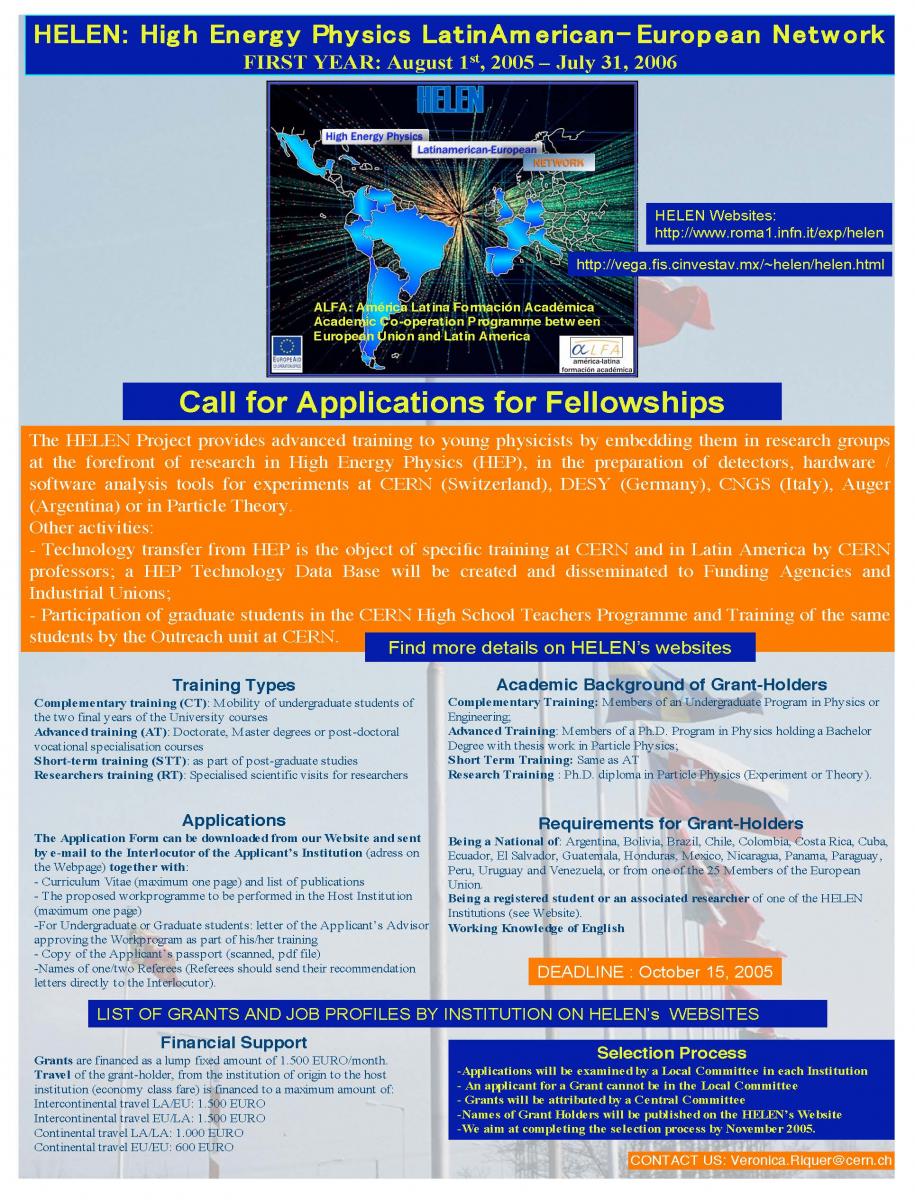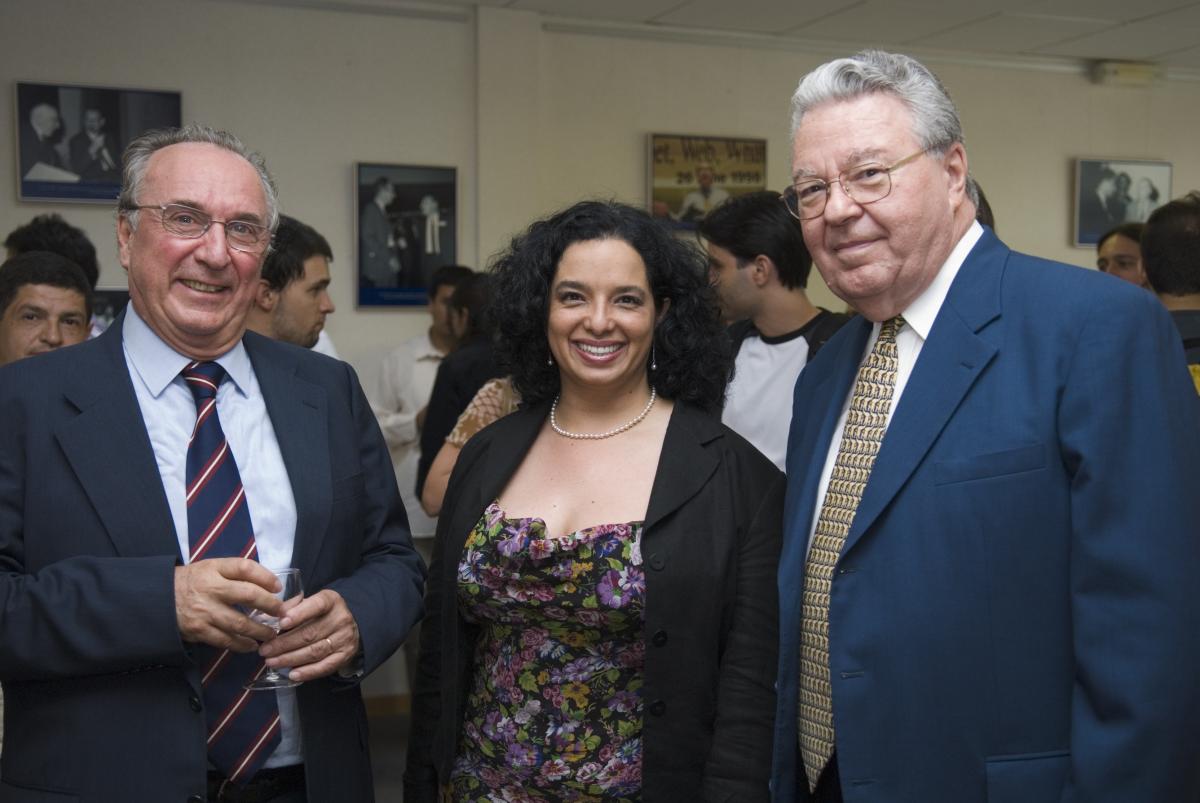Interview with Luciano Maiani and Veronica Riquer
How did you become involved with the EPLANET project?
L.M. When I was Director General I happened to discuss the future of Latin America with Juan Antonio Rubio. He convinced me that Latin America had endless possibilities for development, especially in the field of particle physics.
 In addition, I noticed that many European scientists participated in the Auger experiment that was set up in Argentina in 2001. It occurred to me that the LHC and the Auger could constitute the basic elements of a Latin American- European collaboration. We discussed this subject with Philip Buscuin, the European Commissioner for research, in 2002 and he mentioned that the European Commission was interested in Latin America. It had launched a project which was called ALFA - that stands for America Latina Formacion Academica. He suggested that we carry out a project for ALFA, therefore I collaborated with Juan Antonio Rubio and Veronica Riquer. The result of our collaboration was project HELEN, i.e. High Energy Physics Latin American- European Network, which was submitted in 2004 and approved in 2005. The Latin American countries that participated in HELEN were Mexico, Chile, Brazil, Argentina, Colombia, Cuba, Venezuela and Peru. The project was a great success and it realized our dream of establishing a bridge between Latin American and European countries. More specifically, this collaboration allowed the exchange of young people. Before HELEN only the acknowledged scientists could get funding from their governments in order to travel abroad. The real novelty that HELEN brought was that even undergraduate students could receive financial support. As a result, a large Latin American community developed at CERN.
In addition, I noticed that many European scientists participated in the Auger experiment that was set up in Argentina in 2001. It occurred to me that the LHC and the Auger could constitute the basic elements of a Latin American- European collaboration. We discussed this subject with Philip Buscuin, the European Commissioner for research, in 2002 and he mentioned that the European Commission was interested in Latin America. It had launched a project which was called ALFA - that stands for America Latina Formacion Academica. He suggested that we carry out a project for ALFA, therefore I collaborated with Juan Antonio Rubio and Veronica Riquer. The result of our collaboration was project HELEN, i.e. High Energy Physics Latin American- European Network, which was submitted in 2004 and approved in 2005. The Latin American countries that participated in HELEN were Mexico, Chile, Brazil, Argentina, Colombia, Cuba, Venezuela and Peru. The project was a great success and it realized our dream of establishing a bridge between Latin American and European countries. More specifically, this collaboration allowed the exchange of young people. Before HELEN only the acknowledged scientists could get funding from their governments in order to travel abroad. The real novelty that HELEN brought was that even undergraduate students could receive financial support. As a result, a large Latin American community developed at CERN.
V.R. When I arrived at CERN in 2003 I learned that there was an interest to attract the High Energy Physics Community of Latin America to the project of the LHC. LEP had given all these wonderful results and the projects for building the world’s largest hadron collider at CERN were already endorsed. The building of the LHC and the physics potential of the machine were calling for an international collaboration.
Juan Antonio Rubio and Luciano Maiani had already the idea of a project that would encourage researchers and students from Latin America to work at the LHC. I was so excited by their project that I immediately decided to join in. Since I already knew most of the physicists in our field in Latin America I considered this a personal challenge. The project could offer HEP physicists new opportunities for boosting their career. We launched the HELEN project that was submitted in the framework of the ALFA program. I was deeply involved in setting up the network of laboratories and universities that were participating in HELEN and I carried out some of the heavy-administrative work for the project.
You will probably find the story of the submission of the proposal for HELEN to the European Commission quite amusing. The deadline for submitting all proposals was the 30th of April and on the night before I stayed at CERN working till the early morning. Around 07:00am a secretary arrived and offered to travel to Brussels to submit the proposal, as we didn’t have enough time to send it by courier. On top of that, as she was running to catch her flight in the airport she had an accident. Like in one of these action films her suitcase opened and the documents were scattered all over the airport. Thankfully, she managed to collect them and submit the proposal. However, when we received a confirmation from the Commission it stated that “all documents are in disorder”. In the end, the project was approved and the commission agreed to the budget that we had asked for. They realized the importance of this project.

Veronica Riquer and Luciano Maiani during the first Helen’s Executive Board meeting in Rio de Janeiro, Nov., 2005
What were the first contacts that you had in Latin America?
L.M. Juan Antonio Rubio and Veronica Riquer knew essentially everybody in Latin America. The starting point was the CERN Latin American School that was organized by Juan Antonio Rubio in 2001. At the time, there was already a number of people in Mexico, in Brazil and in Argentina that had some connection to CERN, therefore we did not encounter singnificant problems in having people associating with this enterprise.

Spring 2006. From left: Luciano Maiani, Veronica Riquer and the Director General Robert Aymar celebrate the start of HELEN at CERN.
What happened when the HELEN project ended?
V.R. Naturally, we felt a bit sad when the program finished and we considered running HELEN-II. Unfortunately, this was not possible as the rules of the ALFA programme had changed. We spent some time looking for different EU programmes that could ensure the continuation of the project. The opportunity came with the 7th Framework Programme – Marie Curie People. The guidelines were different this time and only Latin American countries that had signed a special kind of agreement with the EU could participate. The approval of the Programme has been a nice surprise, since it was oriented towards the support of Europeans that travel to Latin America, whereas in the EPLANET project the majority of people travel from Latin America to Europe
L.M. Unfortunately there was a big interruption between the end of HELEN and the start of EPLANET, with the latter starting February 2011 and the former having finished April 2009. In the beginning, EPLANET encountered some difficulties mainly due to organizational reasons. Consequently, many groups could not work on the project, even though they wanted to. However, these problems have now been dealt with and we are making good progress. It should also be mentioned that HELEN resulted in agreements made for instance by Chile with ATLAS, by Argentina with ATLAS etc. In Brazil the Tier 2 of the LHC data GRID was made. In view of these achievements, EPLANET aims to consolidate collaborations, thus stabilizing the relationships of these countries with CERN. In addition, EPLANET has been very useful in boosting European participation in Auger. Hence, the collaboration worked both ways. Obviously, the groups from Latin America that come to CERN are more than those who go from Europe to Auger but it is nevertheless a significant enterprise.
What do you expect from EPLANET in the future?
L.M. I would like to see some of the countries that participate in the project establishing permanent relationships with CERN. This means stabilization of the financial support for HEP research in these countries, a problem that has always been the endemic disease of physics, particle physics in particular, in Latin America. Juan Antonio Rubio gave me a lengthy report on the situation in Latin America in 2000-2001 and the evidence that emerged demonstrated the difficulty of physics groups to get stable financial support. Clearly, HELEN and EPLANET have proved to the governments that with solid support many things can be done. I really hope that these countries will become permanent members of the CERN community. I don’t think I will participate in another project but maybe somebody else will take the lead. Finally, I hope that there will be another European project after EPLANET ends.
